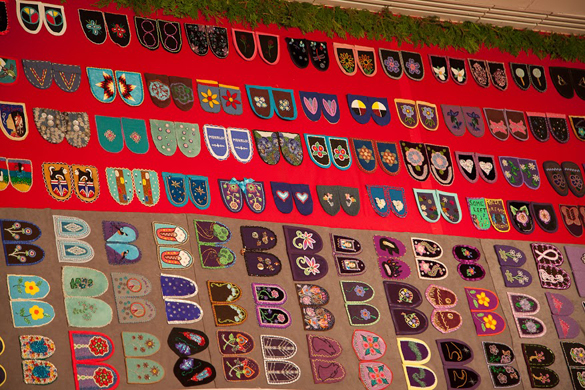
Photo by Melody McKiver / Walking With Our Sisters
At the beginning of my first-year survey in architectural history, I claim that architecture, at its very origins, is fundamentally about making space into something meaningful. That transformation has been achieved, with overwhelming power and poignancy, at an exhibition that is up for just a few more days at the Carleton University Art Gallery.
Walking with our Sisters commemorates the more than 1,180 Indigenous women, girls and Two-Spirit people murdered or missing in Canada over the last three decades. Paradoxically, each one of those 1,180 is palpably present, represented by a pair of moccasin vamps (uppers) arranged in a processional path winding through the gallery space, surrounded by fabric, medicinal cedar boughs, and other ritual objects.
This is not an exhibition to be merely looked at. It must be enacted by the visitor. After removing our shoes and being invited to cleanse with fragrant sage smoke, we pass into the ritual space. As we add our footsteps to the hundreds aligned silently and still beside us, the immense scale of the tragedy becomes an object of visceral experience.

Photo by Melody McKiver / Walking With Our Sisters
Each pair of vamps is unique and hand-made by someone touched by this tragedy. Each is a distinct voice, a personal gesture of mourning, a private lament for a lost sister, daughter, friend, or loved one. Every pair is a half-told story; a trace of someone who will never again be wholly present, or wholly absent. It is not about the 1,180. It is about the one, multiplied 1,180 times. Step after step after step, the sheer volume becomes almost unbearable – will it ever end? That, of course, is the burning question. Will it ever end?
To become truly eloquent, a space must be more than beautiful. It must communicate and dramatize things that matter deeply to us. It must envelop our bodies and focus all of our senses. That is the great achievement here of CUAG, of artist Christi Belcourt, of her hundreds of collaborators across North America, and of the army of volunteers who helped install the exhibition, maintain it, and guide us through it. They have created a deeply caring and compassionate space, which, perhaps surprisingly, becomes powerfully hopeful. The exhibition is solemn, but solemn is not all that it is.
More than anything, this exhibition demands that we bear witness. Judging by the crowds at CUAG, that demand is not going unheeded. To take back a deeply unfortunate phrase from the political leadership of our time, it is on our radar.